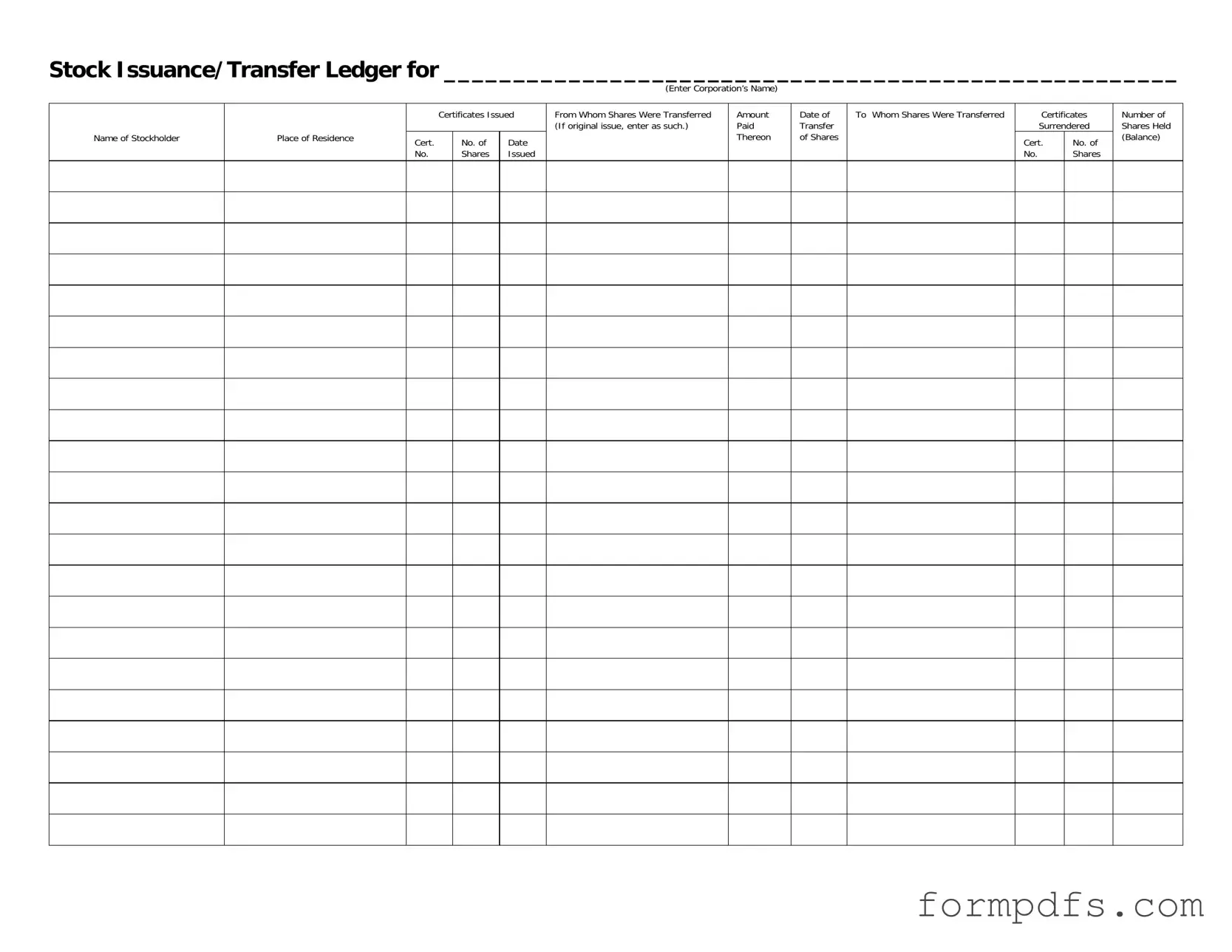What is the purpose of the Stock Transfer Ledger form?
The Stock Transfer Ledger form is used to document the issuance and transfer of stock shares within a corporation. It serves as an official record that tracks who owns the shares, the number of shares issued, and any changes in ownership over time. This documentation is crucial for maintaining accurate corporate records and ensuring compliance with relevant laws and regulations.
What information is required to complete the Stock Transfer Ledger form?
To complete the form, you need to provide the corporation's name, the name of the stockholder, their place of residence, details about the certificates issued (including certificate numbers and the number of shares), the amount paid for the shares, the date of transfer, and the names of both the transferor and transferee. This comprehensive information helps maintain clarity and transparency in stock ownership.
Who is responsible for maintaining the Stock Transfer Ledger?
The responsibility for maintaining the Stock Transfer Ledger typically falls on the corporation's secretary or designated officer. This individual ensures that all entries are accurate and up-to-date, reflecting any changes in stock ownership as they occur. Proper maintenance of the ledger is essential for legal compliance and shareholder communication.
How does one transfer shares using the Stock Transfer Ledger form?
To transfer shares, the current owner must fill out the Stock Transfer Ledger form, providing details about the shares being transferred, including the certificate number and the number of shares. The form must then be signed by the transferor and submitted to the corporation. The corporation will update the ledger to reflect the new ownership and issue new certificates if necessary.
What happens if the Stock Transfer Ledger is not properly maintained?
If the Stock Transfer Ledger is not properly maintained, it can lead to disputes regarding ownership and potentially result in legal complications. Inaccurate records may affect shareholder rights and the corporation’s ability to comply with regulatory requirements. Maintaining an accurate ledger is vital for protecting both the corporation and its shareholders.
Can a Stock Transfer Ledger be amended after it has been completed?
Yes, a Stock Transfer Ledger can be amended, but it should be done with caution. Any changes must be documented properly, including the reason for the amendment and the date it was made. It is advisable to keep a record of all amendments to maintain transparency and accuracy in the corporation's records.
Is there a specific format for the Stock Transfer Ledger form?
The Stock Transfer Ledger form typically follows a standard format that includes specific fields for entering information about the corporation, stockholder, shares issued, and transfers. While there may be variations depending on the corporation's needs, it is important to ensure that all necessary information is captured in a clear and organized manner.
What should be done if a stock certificate is lost or destroyed?
If a stock certificate is lost or destroyed, the stockholder should notify the corporation immediately. The corporation may require a formal declaration of loss and may issue a replacement certificate after verifying ownership. It is important to follow the corporation's specific procedures to ensure that the stockholder's rights are protected.
How can shareholders access the Stock Transfer Ledger?
Shareholders typically have the right to access the Stock Transfer Ledger upon request. The corporation may have specific policies regarding how and when shareholders can view the ledger. It is advisable for shareholders to contact the corporation directly to understand the process and any requirements for accessing this important document.
What role does the Stock Transfer Ledger play in corporate governance?
The Stock Transfer Ledger plays a critical role in corporate governance by providing a clear record of ownership and facilitating communication between the corporation and its shareholders. It helps ensure that shareholders can exercise their rights, such as voting and receiving dividends, and it supports the corporation's compliance with legal and regulatory obligations.
